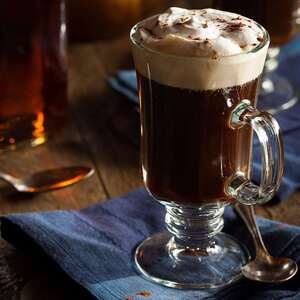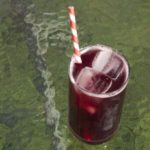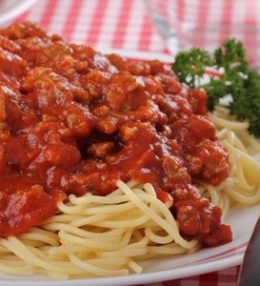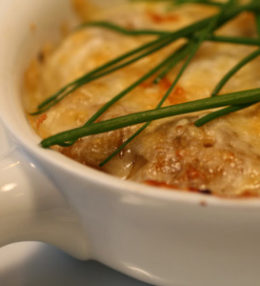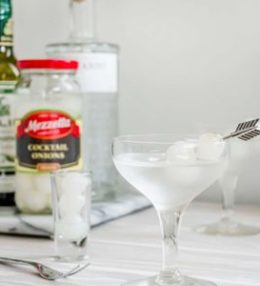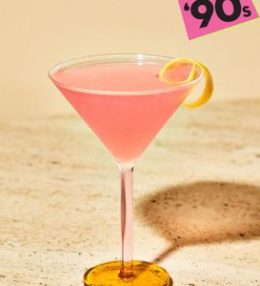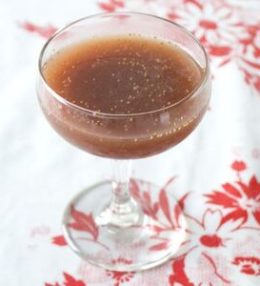
The best Irish Coffee I’ve ever had was at the Slane Distillery, about an hour north of Dublin, in what was once a stable for horses and is now a snug bar with spacious booths. Irish Coffee often means a haphazard mixture of booze, cream, and coffee, something close to a hot whiskey milkshake. But at Slane, the Irish Coffee was exactly what I want on a chilly, drizzly day: a double shot of espresso cut with good whiskey and sweetened just slightly with vanilla-infused Demerara syrup, topped with a cloud of softly whipped cream and orange-flavored chocolate shavings. It was the exact right proportion of coffee to cream and syrup, barely sweet, anchored by the notes of vanilla and sherry in the whiskey. I haven’t stopped thinking about it since.
Irish Coffee, like so many St. Patrick’s Day culinary standbys, is more Irish-American than Irish. Like many cocktails, the origin story is somewhat murky, but the most popular version claims created in 1952 at the Buena Vista restaurant in San Francisco, after a patron wanted to recreate a popular coffee drink he enjoyed at the Shannon airport. The original cocktail features aged, frothed cream, two sugar cubes, hot coffee, and Irish whiskey, but as the drink spread, different formulations took hold. If you order an Irish Coffee today, you’ll often get something much creamier and sweeter, sometimes including Irish cream liqueur or commercial flavored syrups.
Irish Coffee, made properly, doesn’t just taste good, it can look like a beautiful, layered cocktail; at the Slane, they serve it in tall, thin glass coffee mugs. If you don’t have one of those, opt for a generously sized, sturdy wine or beer glass, so you can hold the hot drink coffee by the stem. Jillian Vose, Irish Coffee expert and former beverage director of The Dead Rabbit in Manhattan, notes that using too large a glass is one of the biggest mistakes she sees in making an Irish Coffee. The ideal ratio is one ounce of whiskey to six ounces of coffee—a fairly small serving. “This should be a session drink. Using a large glass makes for a boozy, bitter coffee and under sweetened drink typically,” Vose said. “It’ll also get cold halfway through with a larger serve.”
Similarly, since coffee is such a big part of the drink, you want strong, freshly brewed stuff that you like to drink. Many inferior Irish Coffees go wrong from the start, using stale coffee and then trying to cover it up with too many additions. Instead, pare down, and break out the good stuff, or at least coffee that you’d drink a fresh cup of without complaint. “Don’t use old coffee,” Vose said. “It makes for a burnt taste.”
Using a small amount of sweetener is another opportunity to elevate the drink. “For example, we use a vanilla- infused syrup to highlight the vanilla notes that come from our virgin oak cask, one of the three casks we use when maturing our blend,” noted Alex Conyngham, the co-founder of Slane Distillery. At Slane, they use two-thirds part syrup to one part whiskey, but at home, use a teaspoon of simple syrup and taste as you go until you hit a balance with the coffee and whiskey that you prefer.
The bartending team at Slane Distillery built the Irish Coffee around the whiskey itself, Slane co-founder Alex Conyngham told me — so quality is crucial. Use a whiskey you’d drink neat. Old standbys like Jameson and Bushmills work well, but there’s a new emerging class of good Irish whiskies to consider, like Slane and Teeling.
The same goes for the whipped cream on top. Skip the stuff that comes out of a can, and opt for heavy cream, whipped until it has thickened but not yet stiff. “To get the most out of this cocktail, you really need to drink it through the velvety, lightly whipped heavy cream,” Conyngham said. Jillian Vose agrees. “The key is to whip heavy cream until the bubbles are gone but not to the point of it being able to peak. It should pour on top of the liquid easily and the outcome should look like a perfectly poured Guinness,” Vose said.
To achieve that perfect layer of cream, spoon it onto the coffee gently—you want it to float on top, merging into the coffee gently as you’re drinking it, rather than blending in all at once. To get that coveted float, Conyngham said, “pour it gently over the back of an angled teaspoon.” At the Dead Rabbit, Vose has another trick. “We do a serious amount of volume of the Irish Coffee at our bar, so we use protein shaker bottles and are continuously refilling them.”
Cook Mode
(Keep screen awake)
Ingredients
-
1 ounce Irish whiskey
-
3/4 ounces simple syrup
-
3 1/4 ounces coffee
-
2 tablespoons whipped cream (for garnish)
Directions
-
Add the whiskey, coffee and simple syrup into a tall, thin glass, and stir to combine.
-
Garnish with whipped cream and grated nutmeg.
The best Irish Coffee I’ve ever had was at the Slane Distillery, about an hour north of Dublin, in what was once a stable for horses and is now a snug bar with spacious booths. Irish Coffee often means a haphazard mixture of booze, cream, and coffee, something close to a hot whiskey milkshake. But at Slane, the Irish Coffee was exactly what I want on a chilly, drizzly day: a double shot of espresso cut with good whiskey and sweetened just slightly with vanilla-infused Demerara syrup, topped with a cloud of softly whipped cream and orange-flavored chocolate shavings. It was the exact right proportion of coffee to cream and syrup, barely sweet, anchored by the notes of vanilla and sherry in the whiskey. I haven’t stopped thinking about it since. Irish Coffee, like so many St. Patrick’s Day culinary standbys, is more Irish-American than Irish. Like many cocktails, the origin story is somewhat murky, but the most popular version claims created in 1952 at the Buena Vista restaurant in San Francisco, after a patron wanted to recreate a popular coffee drink he enjoyed at the Shannon airport. The original cocktail features aged, frothed cream, two sugar cubes, hot coffee, and Irish whiskey, but as the drink spread, different formulations took hold. If you order an Irish Coffee today, you’ll often get something much creamier and sweeter, sometimes including Irish cream liqueur or commercial flavored syrups. Irish Coffee, made properly, doesn’t just taste good, it can look like a beautiful, layered cocktail; at the Slane, they serve it in tall, thin glass coffee mugs. If you don’t have one of those, opt for a generously sized, sturdy wine or beer glass, so you can hold the hot drink coffee by the stem. Jillian Vose, Irish Coffee expert and former beverage director of The Dead Rabbit in Manhattan, notes that using too large a glass is one of the biggest mistakes she sees in making an Irish Coffee. The ideal ratio is one ounce of whiskey to six ounces of coffee—a fairly small serving. “This should be a session drink. Using a large glass makes for a boozy, bitter coffee and under sweetened drink typically,” Vose said. “It’ll also get cold halfway through with a larger serve.” Similarly, since coffee is such a big part of the drink, you want strong, freshly brewed stuff that you like to drink. Many inferior Irish Coffees go wrong from the start, using stale coffee and then trying to cover it up with too many additions. Instead, pare down, and break out the good stuff, or at least coffee that you’d drink a fresh cup of without complaint. “Don’t use old coffee,” Vose said. “It makes for a burnt taste.” Using a small amount of sweetener is another opportunity to elevate the drink. “For example, we use a vanilla- infused syrup to highlight the vanilla notes that come from our virgin oak cask, one of the three casks we use when maturing our blend,” noted Alex Conyngham, the co-founder of Slane Distillery. At Slane, they use two-thirds part syrup to one part whiskey, but at home, use a teaspoon of simple syrup and taste as you go until you hit a balance with the coffee and whiskey that you prefer. The bartending team at Slane Distillery built the Irish Coffee around the whiskey itself, Slane co-founder Alex Conyngham told me — so quality is crucial. Use a whiskey you’d drink neat. Old standbys like Jameson and Bushmills work well, but there’s a new emerging class of good Irish whiskies to consider, like Slane and Teeling. The same goes for the whipped cream on top. Skip the stuff that comes out of a can, and opt for heavy cream, whipped until it has thickened but not yet stiff. “To get the most out of this cocktail, you really need to drink it through the velvety, lightly whipped heavy cream,” Conyngham said. Jillian Vose agrees. “The key is to whip heavy cream until the bubbles are gone but not to the point of it being able to peak. It should pour on top of the liquid easily and the outcome should look like a perfectly poured Guinness,” Vose said. To achieve that perfect layer of cream, spoon it onto the coffee gently—you want it to float on top, merging into the coffee gently as you’re drinking it, rather than blending in all at once. To get that coveted float, Conyngham said, “pour it gently over the back of an angled teaspoon.” At the Dead Rabbit, Vose has another trick. “We do a serious amount of volume of the Irish Coffee at our bar, so we use protein shaker bottles and are continuously refilling them.” Cook Mode (Keep screen awake) Ingredients 1 ounce Irish whiskey 3/4 ounces simple syrup 3 1/4 ounces coffee 2 tablespoons whipped cream (for garnish) Directions Add the whiskey, coffee and simple syrup into a tall, thin glass, and stir to combine. Garnish with whipped cream and grated nutmeg.
Irish Coffee


